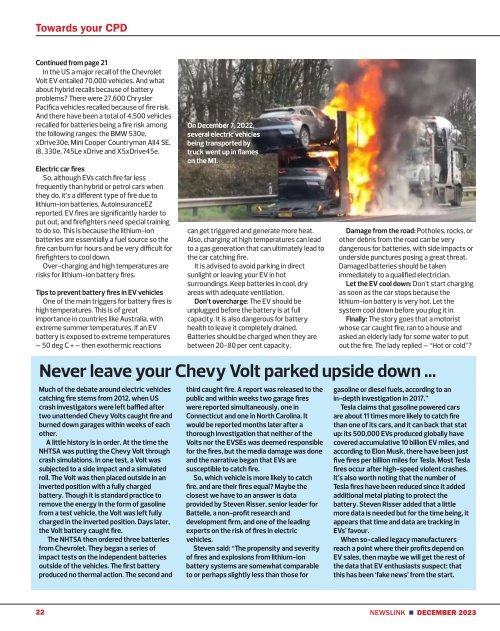Newslink December final
Motor Schools Association members magazine; driver training and testing; road safety
Motor Schools Association members magazine; driver training and testing; road safety
You also want an ePaper? Increase the reach of your titles
YUMPU automatically turns print PDFs into web optimized ePapers that Google loves.
Towards your CPD<br />
Continued from page 21<br />
In the US a major recall of the Chevrolet<br />
Volt EV entailed 70,000 vehicles. And what<br />
about hybrid recalls because of battery<br />
problems? There were 27,600 Chrysler<br />
Pacifica vehicles recalled because of fire risk.<br />
And there have been a total of 4,500 vehicles<br />
recalled for batteries being a fire risk among<br />
the following ranges: the BMW 530e,<br />
xDrive30e, Mini Cooper Countryman AII4 SE,<br />
i8, 330e, 745Le xDrive and X5xDrive45e.<br />
Electric car fires<br />
So, although EVs catch fire far less<br />
frequently than hybrid or petrol cars when<br />
they do, it’s a different type of fire due to<br />
lithium-ion batteries, AutoinsuranceEZ<br />
reported. EV fires are significantly harder to<br />
put out, and firefighters need special training<br />
to do so. This is because the lithium-ion<br />
batteries are essentially a fuel source so the<br />
fire can burn for hours and be very difficult for<br />
firefighters to cool down.<br />
Over-charging and high temperatures are<br />
risks for lithium-ion battery fires.<br />
Tips to prevent battery fires in EV vehicles<br />
One of the main triggers for battery fires is<br />
high temperatures. This is of great<br />
importance in countries like Australia, with<br />
extreme summer temperatures. If an EV<br />
battery is exposed to extreme temperatures<br />
– 50 deg C + – then exothermic reactions<br />
On <strong>December</strong> 7, 2022,<br />
several electric vehicles<br />
being transported by<br />
truck went up in flames<br />
on the M1.<br />
can get triggered and generate more heat.<br />
Also, charging at high temperatures can lead<br />
to a gas generation that can ultimately lead to<br />
the car catching fire.<br />
It is advised to avoid parking in direct<br />
sunlight or leaving your EV in hot<br />
surroundings. Keep batteries in cool, dry<br />
areas with adequate ventilation.<br />
Don’t overcharge: The EV should be<br />
unplugged before the battery is at full<br />
capacity. It is also dangerous for battery<br />
health to leave it completely drained.<br />
Batteries should be charged when they are<br />
between 20-80 per cent capacity.<br />
Damage from the road: Potholes, rocks, or<br />
other debris from the road can be very<br />
dangerous for batteries, with side impacts or<br />
underside punctures posing a great threat.<br />
Damaged batteries should be taken<br />
immediately to a qualified electrician.<br />
Let the EV cool down: Don’t start charging<br />
as soon as the car stops because the<br />
lithium-ion battery is very hot. Let the<br />
system cool down before you plug it in.<br />
Finally: The story goes that a motorist<br />
whose car caught fire, ran to a house and<br />
asked an elderly lady for some water to put<br />
out the fire. The lady replied – “Hot or cold”?<br />
Never leave your Chevy Volt parked upside down ...<br />
Much of the debate around electric vehicles<br />
catching fire stems from 2012, when US<br />
crash investigators were left baffled after<br />
two unattended Chevy Volts caught fire and<br />
burned down garages within weeks of each<br />
other.<br />
A little history is in order. At the time the<br />
NHTSA was putting the Chevy Volt through<br />
crash simulations. In one test, a Volt was<br />
subjected to a side impact and a simulated<br />
roll. The Volt was then placed outside in an<br />
inverted position with a fully charged<br />
battery. Though it is standard practice to<br />
remove the energy in the form of gasoline<br />
from a test vehicle, the Volt was left fully<br />
charged in the inverted position. Days later,<br />
the Volt battery caught fire.<br />
The NHTSA then ordered three batteries<br />
from Chevrolet. They began a series of<br />
impact tests on the independent batteries<br />
outside of the vehicles. The first battery<br />
produced no thermal action. The second and<br />
third caught fire. A report was released to the<br />
public and within weeks two garage fires<br />
were reported simultaneously, one in<br />
Connecticut and one in North Carolina. It<br />
would be reported months later after a<br />
thorough investigation that neither of the<br />
Volts nor the EVSEs was deemed responsible<br />
for the fires, but the media damage was done<br />
and the narrative began that EVs are<br />
susceptible to catch fire.<br />
So, which vehicle is more likely to catch<br />
fire, and are their fires equal? Maybe the<br />
closest we have to an answer is data<br />
provided by Steven Risser, senior leader for<br />
Battelle, a non-profit research and<br />
development firm, and one of the leading<br />
experts on the risk of fires in electric<br />
vehicles.<br />
Steven said: “The propensity and severity<br />
of fires and explosions from lithium-ion<br />
battery systems are somewhat comparable<br />
to or perhaps slightly less than those for<br />
gasoline or diesel fuels, according to an<br />
in-depth investigation in 2017.”<br />
Tesla claims that gasoline powered cars<br />
are about 11 times more likely to catch fire<br />
than one of its cars, and it can back that stat<br />
up: its 500,000 EVs produced globally have<br />
covered accumulative 10 billion EV miles, and<br />
according to Elon Musk, there have been just<br />
five fires per billion miles for Tesla. Most Tesla<br />
fires occur after high-speed violent crashes.<br />
It’s also worth noting that the number of<br />
Tesla fires have been reduced since it added<br />
additional metal plating to protect the<br />
battery. Steven Risser added that a little<br />
more data is needed but for the time being, it<br />
appears that time and data are tracking in<br />
EVs’ favour.<br />
When so-called legacy manufacturers<br />
reach a point where their profits depend on<br />
EV sales, then maybe we will get the rest of<br />
the data that EV enthusiasts suspect: that<br />
this has been ‘fake news’ from the start.<br />
22 NEWSLINK n DECEMBER 2023
















